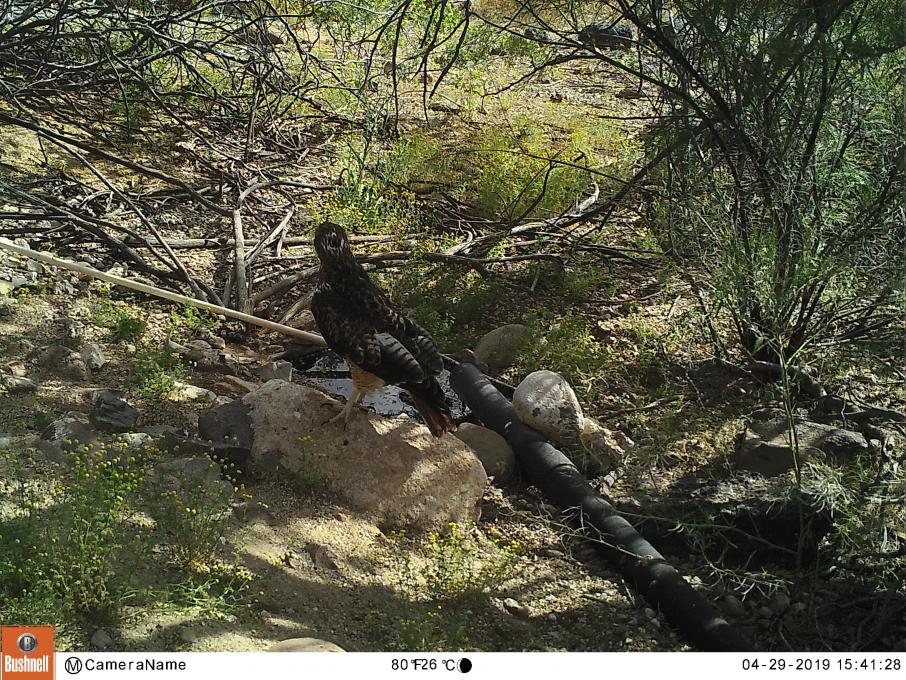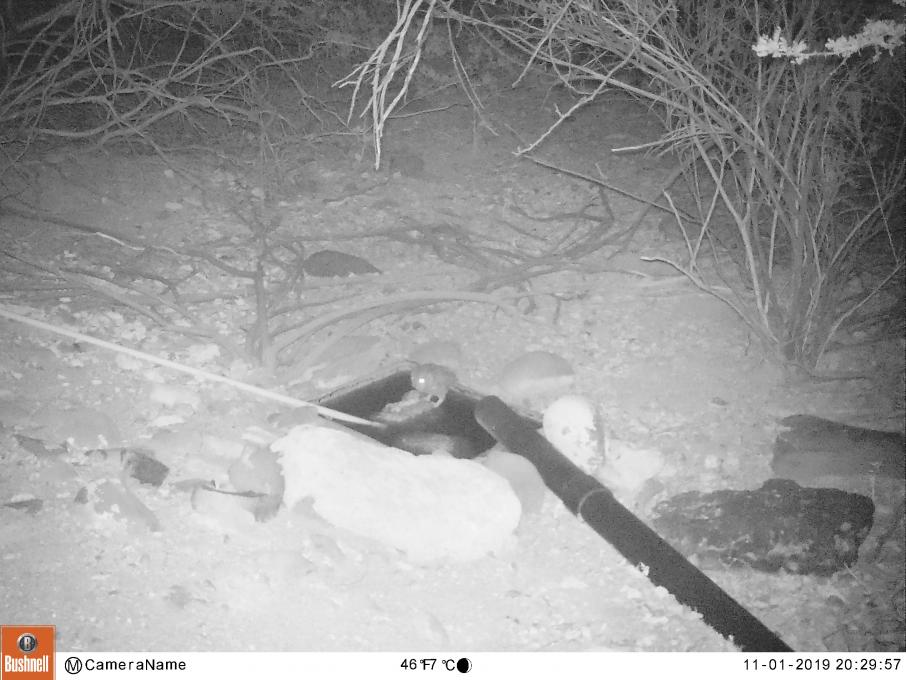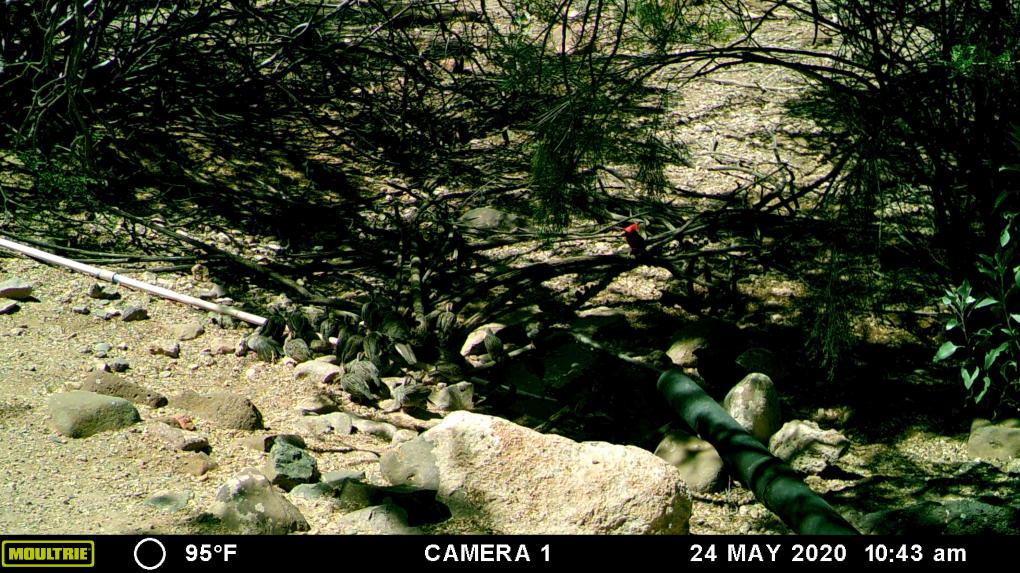The Cornell Lab Bird Academy › Discussion Groups › Joy of Birdwatching › Activities: Local Bird Exploration
-
I forgot to add the variety of wood peckers I have around my home. And the raucous blue jays In winter the downy and hairy wood peckers and the red breasted and white nut hatches are always at my suet. In the forest near me I can finally distinguish between the sounds of the northern flicker and the piliated wood pecker. Occupationally I see the little brown creeper. And on a rare occasion a yellow bellied sap sucker will visit.
-
In front of my home is a good sized river where I see a multitude of ducks migrating in the spring. The great blue heron and some Canada geese stay for the summer. I was so excited to hear the american bittern last week. Behind me is forest so I am learning some of the various birds here. So fascinating. But now I am more able to pick out the many songs and realize all the ones I still do not know. What variety. The first bird I hear in the morning is the pine warbler, then the robin, soon followed by the song sparrow and the red eyed vireo. Ravens, crows, mourning doves, red winged black birds, grackles, chipping sparrows, oven birds, ruby throated hummingbirds and phoebes are common also. Others that I hear less common on my bike rides beside the forest are: blue headed vireo, chestnut sided warbler, yellow rumped warbler, cat bird, veery, wood thrush and one of my favourites: common yellow throated warbler. I took a bike ride to some open farm fields and saw a black bird on a wire. I assumed it to be a red winged black bird but when it took off I could see white patches and heard an intricate long pretty song. I had to go hunting in my bird book and asked the Cornell Lab of Ornithology bird song collection to discover it to be a bobolink. The variety of life, or all our fellow creatures astounds me!

-
Activity 2: On today's walk with the dog, I was able to see some American Robin, Mourning Doves, Barn Swallows, Blue Jays, and House Finches. The Mourning Dove was nice see. I typically only notice the Eurasian Collared Doves, so I'm always happy to see the native birds around. I was also surprised to see a Western Kingbird, which according to Merlin is a most likely species, but I've never seen them in my neighborhood.
-
Yay! this was a helpful section. I figured out how to use Ebird a little bit better, to look up the hot spot and then record a track of neighborhood nature trail and birdwatching area Spenard Crossing in Anchorage Alaska. I didn't know there had been 130 species recorded at this little gem! I was hoping to see a redhed, I'll have to go back. I saw 6 species on my walk.
-
After the rain stopped (June 24th in the afternoon) the feeder on my back deck got busy again. Goldfinches, titmice, nuthatches, downy woodpecker, house finch, and chipping sparrow have all been regular visitors.


-
While it poured rain at my home this afternoon, I spent several peaceful minutes watching the Cornell FeederWatch cam. Immediately I recognized the blue jay, the grackles, and the male cardinal. A woodpecker appeared but was hidden by one of the feeders. I noticed a red patch but I couldn't tell how large the bird was until it moved to another perch. Hairy, for sure! And a little while later, a red-bellied woodpecker! Red-winged blackbirds, several mourning doves, and the cardinal front and center on the platform feeder. I recognized the call of the mourning doves and the squeak of their wings. The red-bellied woodpecker has moved from feeder to feeder, snacking from each one. Here are two I need help with:


-
June 23: a pair of Carolina wrens built a nest in a flower pot outside our kitchen window in southern Rhode Island. We saw them bringing bits of twigs & grass for the nest most of Saturday. We can't see into the nest, but we see one or both of the adults generally around 5:30 AM and at our dinner time. Most of the day the nest is completely quiet, so we're never sure if the birds are still around until one shows up. watering the flowers and working in our kitchen are challenges. In the woods near our house we saw an Orchard oriole nest last week. When I first saw the male near the nest I didn't recognize it as an oriole at first: it is much darker orange-red (the Sibley's calls it chestnut) and slimmer than the Baltimores that I'm more used to. We saw both parents bringing food. The nest was quiet this morning and no sight of the adults.
-
Hi! I now know about grey catbirds...have heard them many times but finally put a face to the song!
-
My son and I are taking this course together. We did these activities and really enjoyed learning about local birds. My son started his life list last week and already has identified 14 birds in our backyard. Instead of doing the suggested activities, we are using what we learned in this lesson to plan our upcoming vacation bird watching since we're going to the beach and aren't as familiar with shore birds. We have our binoculars ready!
-
Activity #1: We went for a walk yesterday and we saw, the Red Tailed Hawk, the Black Phoebe, Bewick's Wren, Northern Mockingbird, a Mourning Dove, and we heard: and Spotted Towhee, and a California Scrub Jay. Activity#2: We have seen many of the birds that were "most likely", but we will try to spot the Dark-Eyed Junco. Activity#3: The birds we did not know about are, the Violet-Green Swallow, the American Kestrel, Costa's Hummingbird, the Mountain Chickadee, and the Peregrine Falcon.

-
1. Bird watching exercise. I looked in the area by my apartment for 10 or 15 minutes for this exercise. I saw crows, sparrows, robins, and many blue jays. I hadn't previously noticed how steeply blue jays could dive, and how quick the birds are. I also noticed that birds often chase each other. I always knew this but now that I am paying more attention, this seems to be more noticeable to me. On this day, the crows and sparrows were chasing each other. But yesterday I saw 2 different species of sparrows chasing each other and actually seeming to fight. I was quite surprised at how aggressive one of them was. 2. Merlin's locality tool. I was very surprised at some of the birds which I could, in theory, see in my area. I also noticed a bird that I could add to my life list, the orchard oriole. Activity 3: Using range maps or bar charts, find five birds that pass through your area that you didn’t know about: I didn't know that the following birds could be in my area: Wood Duck, American Kestrel, Green Heron, Virginia Rail, Cedar WaxWing. I was surprised to see the Peregrine Falcon on the list. The university that I went to in the MidWest helped with an initiative to help increase their population in the 1980s. I was surprised to learn, when I listened to the call recording, that I have likely heard them out East in Maryland where I am currently living.
-

 Saw this northern flicker taking a drink at the pond at Fox Run in Novi, Michigan, June 16, 2020.
Saw this northern flicker taking a drink at the pond at Fox Run in Novi, Michigan, June 16, 2020. -
Wow, great photos! I am never fast enough to get good bird shots.
-
@Jacquie Same here. We need to be very agile and have a good camera with zooming function to get great shots of birds around. I wonder what cameras most people use in the Bird Academy.
-
-
Activity 1: Walking along the shore in our community on Vancouver Island, I noticed three black birds, between a crow and a goose in size, that were sitting out on rocks offshore., and was uncertain about their identity. I am familiar with cormorants as well as Surf Scoters and Black Oystercatchers, but these three did not match exactly the profile of any of these, although the Oystercatcher was my best guess even though I couldn't see red beaks or legs. The Merlin app confirmed this identification based on the posture of the birds perched on the rocks. Activity 2: Most Likely to be seen today? Several at my feeder! Two Bandtailed Pigeons that squeeze themselves into the feeder and sit there to eat are especially amusing. Activity 3: Using ebird bar charts, I searched on my region: Northern Pacific Rainforest, and specified Migration Season to search for five birds that pass through this area that I didn't know about. So many possibilities -- but the real surprises to me, because I thought these birds were more common in the East and I didn't think they would be seen on the west coast of Canada at all, were: Great Egret, Cedar Waxwing, Purple Martin, Yellow Warbler, and California Scrub Jay. I also learned about some birds that I hope to see: Western Tanager, Golden Crowned Kinglet, Western Bluebird, and Red Breasted Sapsucker, if they show up one day in my region.
-
Actividad 1 En el Jardín de mi casa pude observar las siguientes especies de aves Pichitanka (Zonotrichia Capensis), Águila Mora (Geranoaetus Melanoleucos), Gaviota Andina (Chroicocephalus Serranus), Kurkuta (Metropelia Ceciliae), Paloma Manchada (Patagioenas Maculosa), Tortola Torcaza (Zenaida Auriculata), Vencejo Andino (Aeronautes Andecolus), Picaflor Verde (Colibri Curuscans), Picaflor Cometa (Sappho Sparganura), Picaflor Gigante (Patagona Gigas), Carpintero Andino (Colaptes Rupicola), Alkamari (Phalcoboenus Mrgalopterus),Qilli Quilli (Falco Sparverius), Kirki (Psilopsiagan Aymara) Y Canastero Rojizo (Asthenes Dorbignyi) Actividad 2 Las aves que encontré el día de hoy fueron: Águila Mora (Geranoaetus Melanoleucos), Paloma Manchada (Patagioenas Maculosa, Picaflor Verde (Colibri Curuscans), Carpintero Andino (Colaptes Rupicola) Y Alkamari (Phalcoboenus Mrgalopterus) Actividad 3 Los cinco pájaros que pasanpor mi área que no conocía son: Remolinera Común (Cinclodes Albiventris), Chainita Cordillerana (Sparagra Uropygialis), Monterita De Pecho Gris (Poospiza Hypochondria), Mielerito Gris (Conirostrum Cinereum ) Y Amizilia Chionogaster Picaflor De Vientre Blanco.
-
Activity 1: I went out in my backyard (I live just north of Toronto) and just sat there. At first I didn't see any birds, although I heard lots. Eventually I started seeing some birds, picking them out against the trees. I was amazed that after an hour, I had seen 11 species: Northern Cardinal, Downy Woodpecker, White-Breasted Nuthatch, Northern Flicker, Mourning Dove, American Robin, Common Grackle, House Sparrow, American Goldfinch, European Starling -- and then a Ruby-throated Hummingbird came to our feeder. Activity 2: All the birds I saw are on the "Most Likely" list. Nothing rare here -- but still, I was amazed at the diversity! Activity 3: Apparently the Eastern Bluebird, Indigo Bunting, Blue-winged Warbler, Blue-headed Vireo and Black-billed Cuckoo are all in my area. I've only managed to see the last one -- I'm still on the lookout for the other four!
-
Activity 1: My birdwatching spot was on my back deck. I saw Common Grackles, House Finches, Mourning Doves, and an American Robin. I also identified two new birds: a House Wren visiting its nest inside my birdhouse gourd hanging from a tree, and a Song Sparrow eating seed from the ground underneath my feeder (both identified using Merlin!). I heard a warbling song from a tree in my yard, but I was unable to identify the bird it came from. Activity 2: The top seven birds on Merlin’s Most Likely list for my area today are: American Robin (seen today), Red-winged Blackbird (seen today), Ring-billed Gull, Song Sparrow (seen today), American Goldfinch (seen today), Northern Cardinal (seen today), and Common Grackle (seen today). Activity 3: Using eBird, I found the following birds that pass through my area: Yellow-billed Cuckoo, American Coot, Great Black-backed Gull, Green Heron, and Purple Martin.
-
I didn't realize that I had checked "Family" in the Likely tab. Seemed to limit my findings. Switched to "Most Likely" in my current location, and suddenly I started seeing birds I see everyday at the top of the list. Also, I affirmed my identification of this beauty. (It didn't show up in my previous settings) Lifelong goal has been to see this bird in person!
 Great Horned Owl. Located in a tree outside my front door! 5/17/2020
In addition to the owl, I had no idea that I might see Western tanager, Luzuli bunting, wood duck or mute swan in this area. I generally see less colorful birds. I hope to see them around!
Great Horned Owl. Located in a tree outside my front door! 5/17/2020
In addition to the owl, I had no idea that I might see Western tanager, Luzuli bunting, wood duck or mute swan in this area. I generally see less colorful birds. I hope to see them around! -
Beautiful picture. I love the expression on it's face!
-
Changing the setting to Most Likely was a very helpful tip. I was able to make a list of likely birds that I had not seen yet. The plan is to study how they look, compare to similar birds, study their songs. I have already seen one bird on this list, the Wrentit. I am hoping to identify a bird that I hear everyday but have never seen. It makes a distinctive Wheeeeee sound. If anyone has an idea I would love to hear it. And beautiful photo!
-
-
Activity 3. Using range maps or bar charts, find five birds that pass through your area that you didn’t know about. You can look on eBird, in field guides, on All About Birds, or use Merlin. Using these tools I investigated birds that I had never seen and are hard to spot because of where they alight or fly and because they are present but uncommon. I was unaware that the Indigo Bunting was present in this area. The male is very blue when breeding, and the nonbreeding male is more speckled blue. Females are brown overall with whitish throats and a bluish tail. This bird seems to have a thick conical beak, darker gray on top and whitish on the bottom. Juliet Berger, our outstanding local ornithologist, has posted a spectrogram, but I find most calls hard to identify and remember. The Yellow Throated Vireo also appears in some of the natural wooded areas in the county according to hotspot checklists on EBird and Merlin. It is sparrow-sized and has a bright yellow head and eye ring (bright yellow spectacles), a white underside and white wingbars on black wings, with a thick bill that looks grayish blue from photos. It often favors tall trees near water. The Red-Eyed Vireo is similarly shaped but differently color patterned. Most of the photos show a dark or gray cap, a white streak above the eye, and a dark line through the eye. The back is yellowish (some descriptions say olive green). While some descriptions say there are no wing bars (patches), the photos show wings that are streaked with light yellow. Advanced birders say the red eyed vireo has a very recognizable song, a broken series of slurred notes ending in either a downslur or upswing, as well as well as a recognizable call. The vireos forage in deciduous canopies, probably difficult to spot. According to both EBird and Merlin, Chimney Swifts are present in the local area in summer and fall. Birders refer to this swift as a “flying cigar” because of its body shape. It has long, sickle-shaped wings. The bill is very short and hard to see, and the Chimney Swift has a very short tail. Its plumage is dark gray-brown. It flies continuously with constant wingbeats (no glide) during the day and nests and roosts in chimneys. It eats insects. (I spotted some high-flying, continuously flapping dark birds in a small group yesterday evening; the flight pattern and bird shape were something I had never seen before, and I couldn't identify them.)
-
I've been using Merlin for a while but never utilized the "most likely" feature in Explore Birds. Tested it out the other night and it is awesome. I wasn't shocked by the birds at the top of the list--robin, grackle, starling, mourning dove, redwinged blackbird, house sparrow, cardinal--and I think I saw all of them when I went for a walk that evening. One bird that was just outside the top 10 on the list was brown-headed cowbird, which I've seen in my area but not consistently. Voila, what do you supposed landed right in my path that very evening, just a few feet away? :D Was so tickled to see it. "Most Likely" will definitely be my default setting in Merlin from now on. It's also interesting that in just a few days, the birds a little further down the list have changed position significantly...according to Merlin, in the next week or so I need to be looking out for bobolinks and meadowlarks in my area, two birds I never would have bothered to look for before. Just have to find a birding Hot Spot with an open field....
-
Since my vista is my sliding glass door, the array of species I see is fairly limited, however I have identified, by sight and sound: blue jays, cardinals, red-bellied woodpeckers, morning doves, house sparrows, song sparrows, robins, and Grackles. Five species that I didn't know were likely to be seen in the area are wood ducks, gadwalls, northern bobwhite quails, yellow-bellied cuckoos, and chimney swifts.
-
During quarantine (and coincidently, spring migration), birding has been a welcome escape and a perfect pastime! My suburban house is outside Philadelphia and near some small forested areas. I have started a morning habit of drinking my coffee outside and logging birds observed within 20 min or so on eBird, using the Merlin app for any tough-to-identify birds. My friend also lent me her Kaufman's guide so I can practice using a field guide. On a typical morning I average about 13 types of birds - the usual backyard suspects - catbirds, house sparrows, robins, song sparrows, Carolina wrens, blue jays, cardinals, crows, and various woodpeckers (red-bellied most common). This morning I spent a little longer than usual, walking across the street to a field at an abandoned school. I saw a couple pairs of birds that through the Merlin app I was able to identify as Great crested flycatchers with their big round heads and light yellow bellies. They were flitting and flirting around the tops of the trees, must be breeding. Next I heard a peewee, whose song I never would have known without the Merlin app, now I hear it all the time! I followed the song and finally spotted it - it kept me company and sang to me for about 10 minutes! Then I was passing time with a few house finches when I saw another black and white bird I'd never seen before perched on a chain link fence. Thanks to the Merlin app I confirmed it was an Eastern kingbird by the white end of its tail. Finally, I was surprised to hear the "Peter Peter" and see a tufted titmouse singing in the branches right above my head. Honestly I can't think of a better way to spend my Sunday morning!
-
I have just--once again--watched the Cornell Sapsucker Woods live birdcam--love it! I is really helping me in the identification process--meaning that I'm more aware that there are *many* different-but-similar birds, woodpeckers for example. I see them quite a lot around my area (Island of Montreal), but always assumed they were flickers, Downy's or Hairy. The other day the birdcam had two woodpeckers that I realize I didn't know, and they turned out to be the red-bellied--and my newly bought current Bird Guide book (my original, 1964 edition of Roger Tory Peterson really needed renewal....) helped me decide that what I saw was a pair, and how the female and the male differ: the top of the head of the male is almost entirely red, but the female's red is narrower. Wonderful! The Sapsucker birdfeeders were also obviously recently refilled (I had noticed the birds were getting to the bare bottoms...), and so there were a lot of birds, including what I decided were juvenile starlings: one of the adults was obviously helping a little one in the feeding process.
-
Activity 2 and 3 - Use Merlin’s “Most Likely” species feature to find out what birds you are likely to see locally today. Interesting to explore this. Using range maps or bar charts, find five birds that pass through your area that you didn’t know about. I'm looking for the Hooded Oriole more now; 2 friends of mine have them on their property. One built an incredible next on the underside of a palm frond! We do see the European startling - not my favorite bird as they are not native and seem to be bullies. We have see the brown headed Cowbird - I see that we have 2 types of cowbirds; I had thought there was only 1 type. This hawk shows up in the spring - not seen him/her since it got hot

-
Activity 2 and 3 - Use Merlin’s “Most Likely” species feature to find out what birds you are likely to see locally today. Interesting to explore this. Using range maps or bar charts, find five birds that pass through your area that you didn’t know about. I'm looking for the Hooded Oriole more now; 2 friends of mine have them on their property. One built an incredible next on the underside of a palm frond! We do see the European startling - not my favorite bird as they are not native and seem to be bullies. We have see the brown headed Cowbird - I see that we have 2 types of cowbirds; I had thought there was only 1 type.
-
Activity 1: I have 2 places I watch - both on our property. We have a "bird feeding" area where we put some seeds on the ground, some seeds in a feeder, and hummingbird food in a hummingbird feeder. We watch in primarily in the morning (only time we put the seeds out). On the ground, we have mainly have morning doves, white wing doves (although they seem to prefer the feeder), ground doves and gambel quail (sometimes they use the hanging feeder). Cactus Wren show up but seem to be more after the bugs and stuff on the trees. Once in a while we get the Eurasian Collard Dove. We also get a fair number of house finches, sparrows (black chin, house, and I'm working on figuring out the rest), cardinals, albert's towhee, cactus wrens, and curve bill thrashers. In addition to hummingbirds (mainly Ana's), the gila woodpecker and northern flicka use that feeder; some other birds sort of use the feeder - they seem to find the slop over from the woodpecker and flicka. The picture is from our "water hole" where we have a camera. The picture shows a cardinal and one of bigger quail families (we have over a dozen families visiting the water - one group at a time). Some quail families have 2 sets of parents. Sometimes in the night photos, we see a screech owl. Not at the water hole, but we also have great horned owls, burrowing owls


Read More:
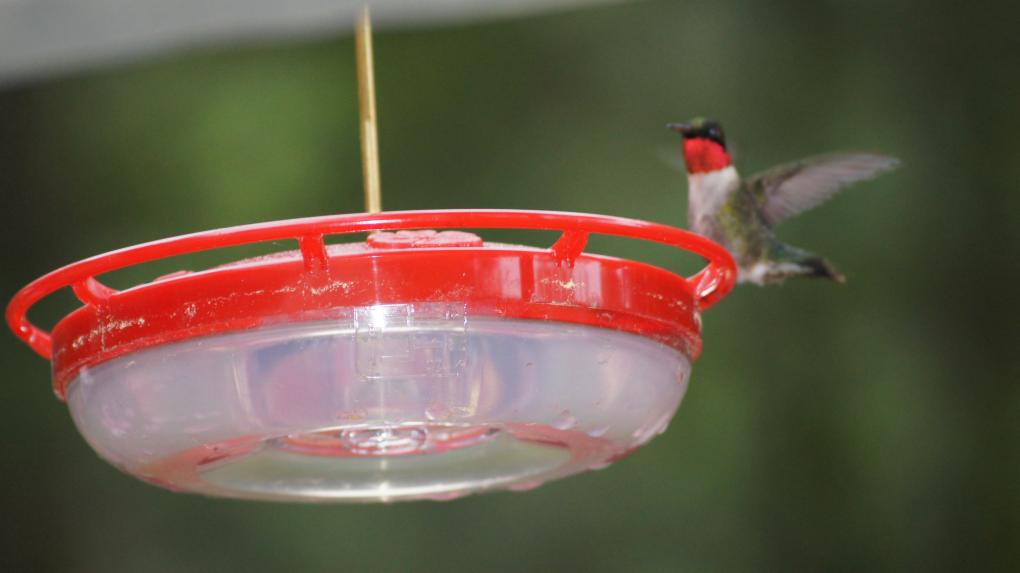
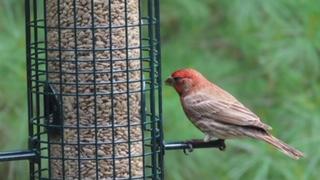


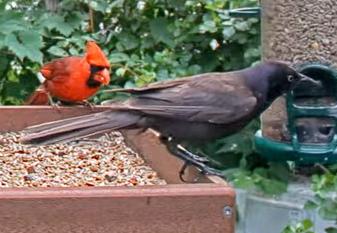


 Saw this northern flicker taking a drink at the pond at Fox Run in Novi, Michigan, June 16, 2020.
Saw this northern flicker taking a drink at the pond at Fox Run in Novi, Michigan, June 16, 2020. 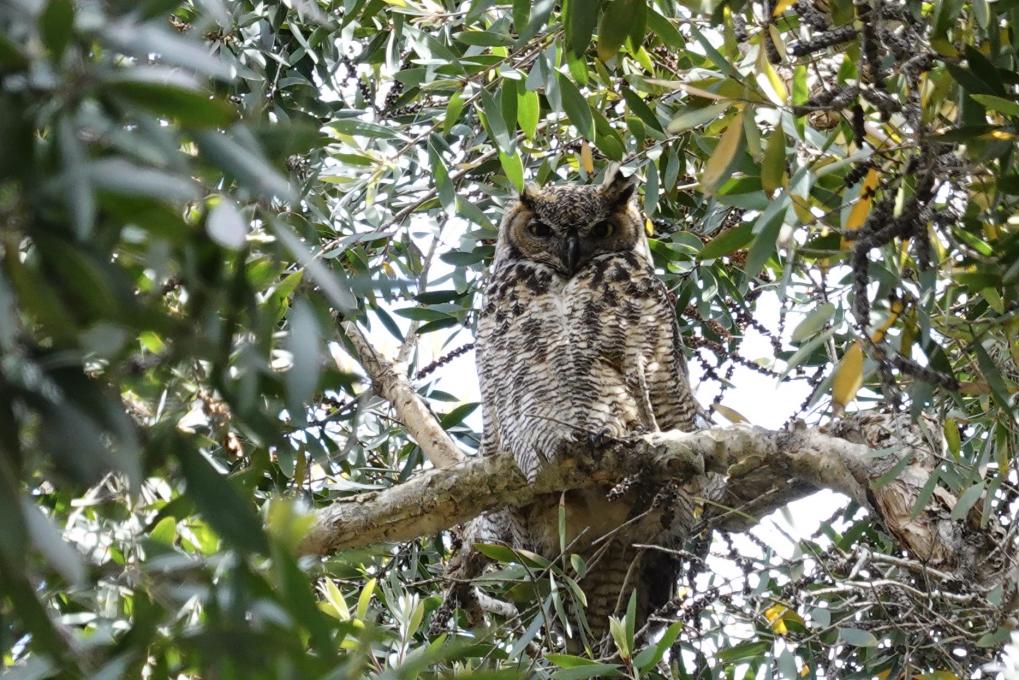 Great Horned Owl. Located in a tree outside my front door! 5/17/2020
In addition to the owl, I had no idea that I might see Western tanager, Luzuli bunting, wood duck or mute swan in this area. I generally see less colorful birds. I hope to see them around!
Great Horned Owl. Located in a tree outside my front door! 5/17/2020
In addition to the owl, I had no idea that I might see Western tanager, Luzuli bunting, wood duck or mute swan in this area. I generally see less colorful birds. I hope to see them around! 